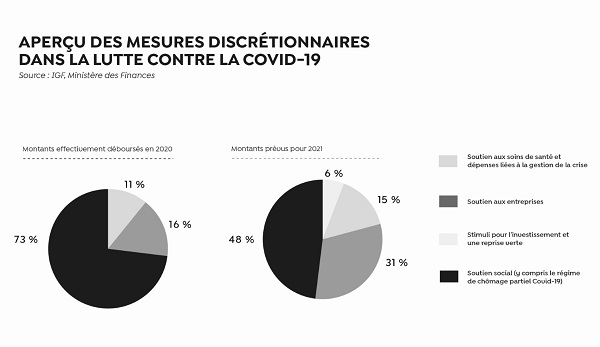 Pierre Gramegna, Luxembourg's Minister of Finance;
Pierre Gramegna, Luxembourg's Minister of Finance;
On Tuesday 27 April 2021, Luxembourg's Minister of Finance, Pierre Gramegna, presented the Stability and Growth Programme for 2021, as well as the national recovery and resilience plan, in plenary session to the Chamber of Deputies (Parliament).
Taking into account the improved economic and budgetary prospects which emerged from this presentation, Minister Pierre Gramegna noted: “One year after the outbreak of the health crisis, I am delighted to be able to place this Stability and Growth Programme under the sign of an emerging exit from the crisis. Luxembourg's economy has shown great resilience and the country has been able to cope with this crisis much better than most of its European peers. This also confirms the validity of the fiscal policy of recent years, focused on qualitative investments, which have been maintained at high levels despite the crisis and will give the country the necessary impetus to build its future on the ecological and digital transition".
Improved macroeconomic outlook
Luxembourg closed the year 2020 with a contraction of its real GDP of -1.3%, which places it among the euro zone and European Union (EU) countries where the impact of the crisis has been best mastered. The Ministry of Finance attributed this smaller than expected contraction (a contraction of -6.0% was forecast in 2020) to the solid fundamentals of the Luxembourg economy, which is characterised by a resilient and diversified socio-economic fabric which has has been able to adapt quickly to the new situation, particularly through the widespread use of teleworking.
According to the Finance Ministry, the very favourable starting budgetary situation in which Luxembourg found itself in 2019 (thanks to the far-sighted policies of the current and previous governments) has made it possible to deploy all the necessary efforts to cushion the economic impact of the crisis.
The total volume of state support measures packages amounted to around €11 billion, or 18.6% of the estimated GDP in 2020. Some of the most important measures included: the extension of short-time working in the context of the COVID-19 crisis, which led to gross disbursements exceeding €1 billion in favour of employees (approx. €600 million net); the payment of €348 million in total in terms of direct aid to businesses; deferrals of payments of taxes, duties and social contributions amounting to €618 million; additional investments of around €231 million in strengthening the health system; the provision of state guarantees for COVID-19 bank loans up to €175 million.
Despite the pandemic, public investments reached a new record level in 2020 and amounted to a total of €3.2 billion. For the year 2021, the level of investments is maintained at a high level of 4.5% of GDP in order to support the way out of the crisis and to continue efforts in favour of a more sustainable and resilient economy.
Recovery and Resilience Plan
While the unprecedented measures taken at national level by EU Member States have had a pronounced stabilising effect, a common response at European level has been essential to support the recovery of the European economy.
Thanks to the €750 billion European recovery plan "Next Generation EU", which will be financed by the exceptional and temporary issue of a common European debt, and with the help of the envelope of €1.074 billion of the Multiannual Financial Framework 2021-2027, the EU now has the necessary financial capacity to face the challenges posed by the dual green and digital transition in a post-COVID-19 context.
The €93.5 million, to which Luxembourg is entitled under the EU's recovery and resilience facility, are intended to complement the €2.9 billion of investments planned by the government for 2021.
Finance Minister Pierre Gramegna commented: “The Luxembourg Recovery and Resilience Plan perfectly reflects the European vision of a sustainable recovery focused on the dual green and digital transition. It will further contribute to the efforts of this government to prepare the country for the challenges of tomorrow, by laying the groundwork for ever more sustainable growth”.
The Luxembourg plan is based on three pillars, relating to the priority areas of the government, namely: cohesion and social resilience; green transition; and digitalisation, innovation and governance. Each pillar is in turn subdivided into one or more “components” under which 20 reform or investment projects are proposed, including the “FutureSkills” and “Digital Skills” initiatives aimed at strengthening and diversifying the professional skills of job seekers and short-time workers, with particular emphasis on the development of digital skills.
In addition, 32% of the total envelope to which Luxembourg is entitled is dedicated to digital investments, the minimum threshold required being 20%.
A gradual return to healthy and balanced public finances
The less negative than expected development of the economy was also reflected in public finances. The deficit of €-2.6 billion euros now recorded for 2020 is a considerable improvement compared to the forecasted deficit of €-5.02 million. This favorable development is largely driven by the evolution of central government revenue, the balance of which amounted to €-3.3 billion instead of €-4.9 billion announced last year, thanks to resilient public revenues and taking into account targeted support measures implemented throughout the year.
The 2021 fiscal year has confirmed this improving trend. During the first quarter of 2021, a positive jaws effect between budgetary expenditure and revenue has already manifested itself and the central government balance has turned green. Taking into account recent developments, the balance is estimated at €-1.359 billion in 2021, which corresponds to -2.0% of GDP. In this second year of crisis, Luxembourg is expected to once again fall below the 3% of GDP mark provided for by the European treaties.
The debt ratio increased by 2.8% in 2020 to reach 24.9% of GDP at the end of the year. Luxembourg is, however, the country in Europe where public debt has increased the least. According to projections, public debt will peak at 28.4% of GDP in 2023 before starting a downward path by 2025 to reach 27.6% of GDP.
The application of the rules of the Stability and Growth Pact in a context of crisis
The 2021 Stability and Growth Pact includes an update of Luxembourg's structural balance over the entire horizon period (2021-2025). In 2021, the structural balance is set to drop to -0.7% of GDP as a result of the improvement in the general government balance and the closing of the output gap. In 2022, the structural balance should drop to -0.3%, before returning to a level close to the medium-term budgetary objective of + 0.5% from the year 2023, which coincides with the very likely reintroduction of the rules of the Stability and Growth Pact.
Luxembourg will send its Stability and Growth Pact for 2021 to the European Commission, together with the national recovery and resilience plan and the national reform programme by 30 April 2021.









